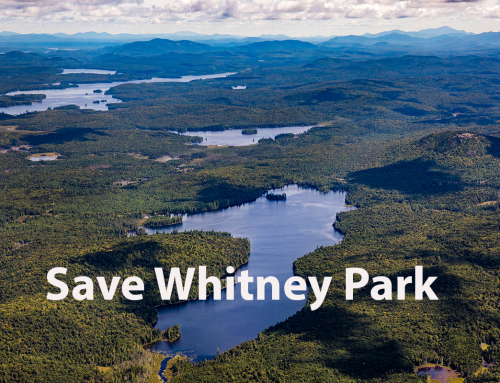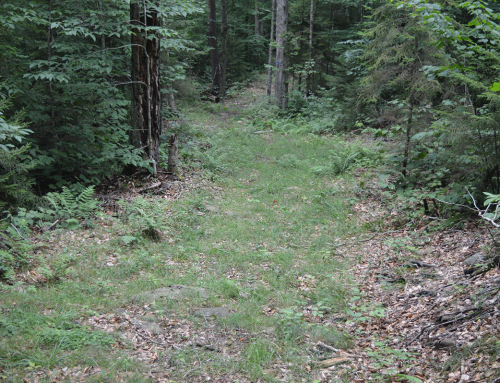The Department of Environmental Conservation (DEC) has released a new draft Unit Management Plan for the Essex Chain Lakes Complex area, which includes lands classified as Primitive and Wild Forest. It’s a vast, sprawling area where many different recreational uses are being combined, some that fit seamlessly with the natural resources and some that damage natural resources and undermine the scenic beauty of the area. Some proposed uses will enhance public outdoor experiences, while other will degrade the public experience and Forest Preserve lands.
It’s important that public comments are made to the DEC by July 27, 2015. See the DEC website for how to submit a comment or see information below.
The Department of Environmental Conservation (DEC) and Adirondack Park Agency (APA) are planning to widely violate state laws, regulations and policies to approve a variety of illegal motor vehicle uses in the Essex Chain Lakes Primitive Area and neighboring Vanderwhacker Mountain Wild Forest area. This UMP widely violates New York’s Wild, Scenic and Recreational Rivers Act, DEC regulations for the Rivers Act, the State Land Master Plan, the Snowmobile Trails Guidance, and long established existing precedent for limiting and managing motor vehicle use.
We need to make a stand today to stop this massive expansion of motor vehicle use in the Forest Preserve.
Essex Chain Lakes Plan Integral to Major Expansion of Motor Vehicle Use
The Adirondack Park is undergoing the greatest expansion of motorized recreational uses in the history of the “forever wild” Forest Preserve. With each new Unit Management Plan (UMP) or amendment, motorized uses are expanded primarily through creation of a major new snowmobile trail network. These large road-like “trails”, called class II community connector snowmobile plans, are unlike any other type of trail on the Forest Preserve. These trails are designed and built for high speed motorized uses.
The principal management objective for the Essex Chain Lakes Complex area should be forest restoration and natural resource preservation. These lands were managed timber lands for more than 100 years. Retention of roads for recreational use will undermine these objectives.
Here are the major issues that we’re focusing on in the Essex Chain Lakes Complex UMP.
Violations of Wild, Scenic and Recreational Rivers Act
The Wild, Scenic and Recreational Rivers Act is being trampled by State agencies. This Act protects the major wild rivers in New York and has been successful for 40 years. Yet, the DEC has proposed a number of actions that gut the Rivers Act and will cause long-term natural resource damage.
1. The Rivers Act prohibits a motor vehicle bridge over the Cedar River, classified as a Scenic River. DEC regulations prohibit motorized uses in a Scenic River corridor and limit trails to four feet in width. DEC is trying to get around these limitations through an elaborate legal contortion that claims there was historic public use for a logging bridge that once stood. This is a novel “grandfathering” legal theory by the DEC that will cause long-term harm to the Forest Preserve by enabling any use of lands when they were in private control before being acquired by the State to be recognized as uses that must be retained in the Forest Preserve. This opens the door for all sorts of activities.
2. The Rivers Act prohibits motor vehicles, such as float planes on Pine Lake or automobiles on the Chain Lake Road South, within the .5-mile corridor of classified as Wild rivers. Wild River corridors should be managed as Wilderness, yet the DEC, through the grandfathering legal theory, seeks to allow motor vehicle use on the Chain Lakes Road South in the Wild River corridor of the Hudson River as well as a special floatplane campsite in the Wild River corridor of the Cedar River that reaches onto the north shore of Pine Lake. Wild River corridors should be managed as motorfree areas, basically Wilderness lands, yet State agencies are seeking to allow motorized uses.
3. While the Rivers Act prohibits motor vehicles in Scenic River corridors, State agencies seek to retain the Polaris Bridge over the Hudson River to facilitate public motorized uses. The Hudson River at the location of the Polaris Bridge is a classified Scenic River corridor. The Polaris Bridge is a vital link in a proposed major new snowmobile trail network. The Polaris Bridge was built for forest management purposes, yet the State is seeking to retain it for public motor vehicle use.
The Wild, Scenic and Recreational Rivers Act must be upheld and not allowed to be trampled by State agencies seeking to build a massive new snowmobile trail system through the public Forest Preserve.
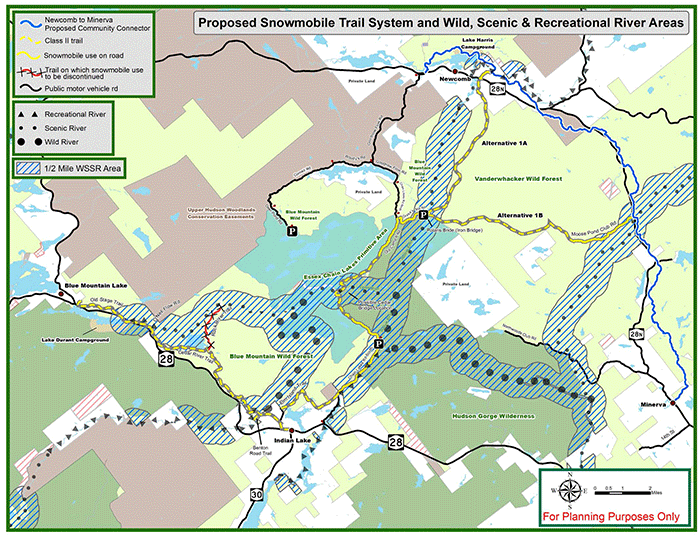
This map highlights the Wild, Scenic and Recreational River corridors within the Essex Chain Lakes Complex area. It’s clear that the proposed new bridge over the Cedar River, Chain Lakes Road South, Polaris Bridge and Pine Lake are all located within a classified river corridor under the Rivers Act. It’s important that the Rivers Act be upheld and these wild and scenic rivers protected.
The Polaris Bridge should be Removed and the Hudson River Restored
The Polaris Bridge over the Hudson River should be removed and the river restored. The bridge crosses a beautiful flatwater stretch of the Hudson, one of the most picturesque spots in the Adirondack Park. The Polaris Bridge is a bridge to nowhere and keeping it will only lead to widespread natural resource degradation as well as violation of state laws, regulations, and policies.
The bridge was part of lands purchased by the state from the Nature Conservancy that included the Essex Chain Lakes and extensive lands along the Hudson. Residual rights for use of the bridge remain until the end of 2018 for private leaseholders. The bridge was built by Finch, Pruyn in the early 1990s, and state permits clearly show that it was for forest management. It was never intended for—and never used for—public recreational purposes.
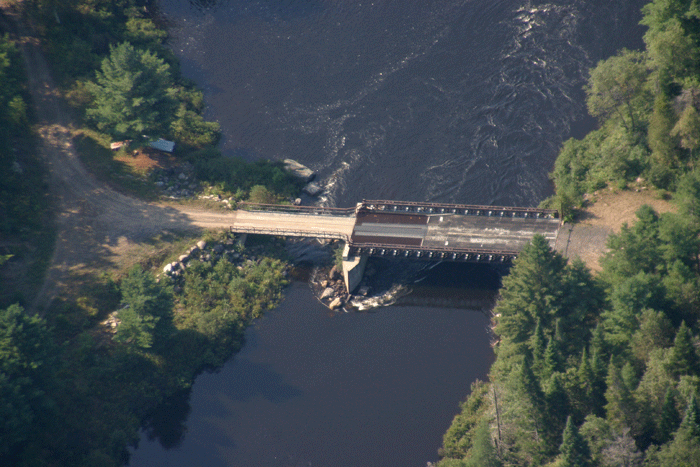
DEC proposes to keep the Polaris bridge. PROTECT believes this violates the Wild, Scenic and Recreational Rivers Act, DEC regulations, and the State Land Master Plan. This bridge should be removed and the river corridor restored, PROTECT supports canoe access/parking area to the Hudson River at the site of the bridge.
No new Snowmobile Trails through the Wild and Trailless Parts of the Vanderwhacker Mountain Wild Forest Area.
Another major problem with the Polaris Bridge is that if retained it will be connected to a highly damaging snowmobile trails system. The DEC is proposing two new trail options, one that is it preferred option, to build new class II community connector trails systems through the wild Vanderwhacker Mountain area. These trails are unnecessary because the APA recently approved a new trail that connects Minerva to Newcomb that largely follows Route 28N. Now, Minerva is connected to Newcomb and Newcomb is also connected to Indian Lake through an existing trail network, so these new trails would be redundant and unnecessary.
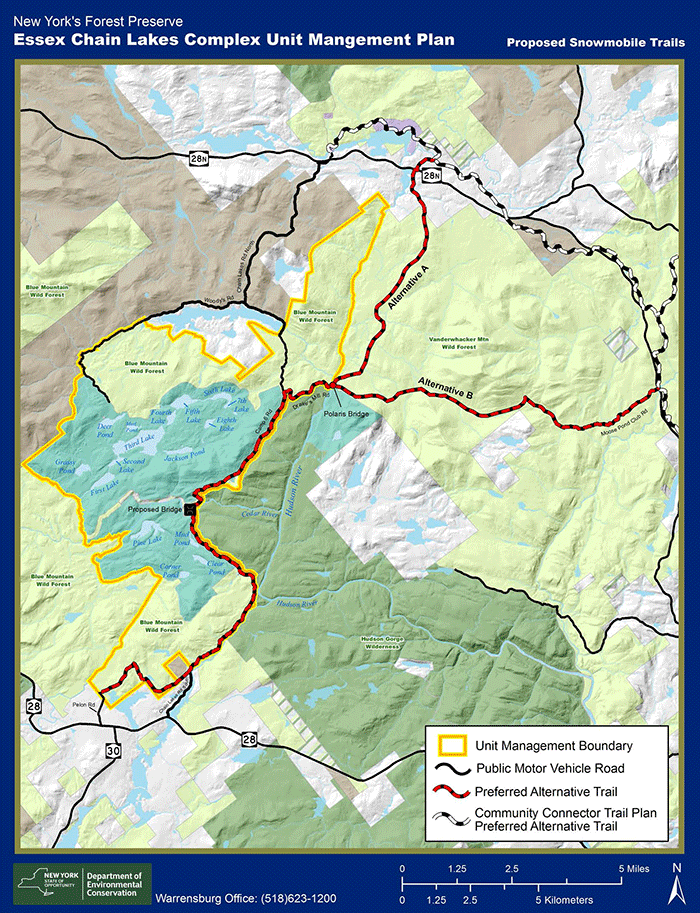
This map shows the two new snowmobile trail options through a wild and trailless part of the Vanderwhacker Mountain WIld Forest that will connect to the Polaris Bridge. PROTECT opposes these trails.
Road between 4th-5th Lakes should be Removed, Corridor Restored
The Wild Forest corridor to 4th-5th Lakes on the Essex Chain violates the State Land Master Plan because it does not facilitate legal motor vehicle use. This road is an illegal peninsula into the Essex Chain Lakes Primitive area and DEC should abandon plans for motor vehicle access on this corridor. The “tube” that allows motor vehicle access across 4th-5th lakes should be removed and that channel ecologically restored.
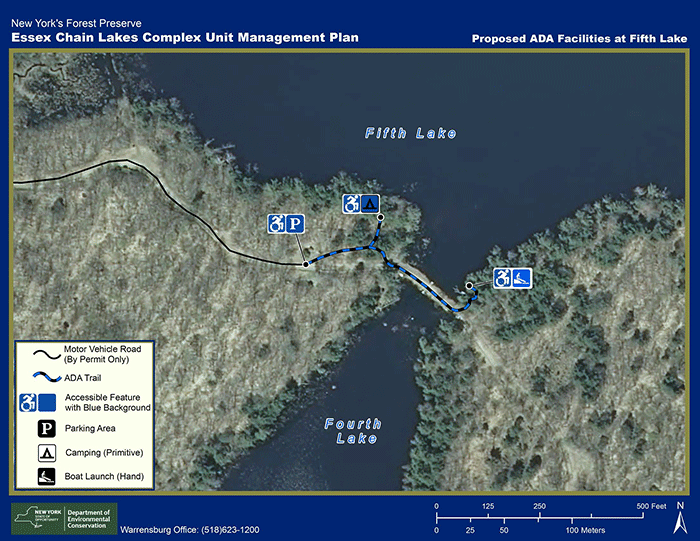
This picture shows the road between 4th-5th lakes on the Essex Chain Lakes. This road should be removed and the channel restored. Special access for the disabled should be facilitated on the north side of 4th or 5th Lake.
Essex Chain Complex UMP Violates Past Precedent and State Snowmobile Plan
DEC’s plans for motor vehicle use within designated Wild and Scenic River corridors violates the Wild, Scenic and Recreational Rivers Act and violates long established management principles, practices, and precedents in long-standing Unit Management Plans, such as the Blue Mountain Wild Forest UMP. That UMP closed a snowmobile trail in a Wild River corridor, when these lands were purchased for the Forest Preserve. Contrary to the past precedent, the DEC is now seeking to allow motor vehicles within a Wild River corridor. The Blue Mountain Wild Forest UMP managed this situation correctly by banning motor vehicle uses within a Wild River corridor.
The proposed Essex Chain Lakes Complex UMP is also contrary to the priorities detailed in the 2006 Snowmobile Plan for the Adirondack Park. This plan contained a list of priority trail systems to link communities throughout the Adirondack Park. This plan is the definitive policy to date of vital community connection trails in the Adirondacks. Under “Community Connection Goals” in the “Trail Section” part of the Snowmobile Plan (pages 45-46), there is no mention of a Minerva-to-Indian Lake snowmobile trail. This was not a major goal for New York and was not recognized as a high priority. The Environmental Impact Study associated with the Snowmobile Plan did not evaluate the impacts of a Minerva-to-Indian Lake trail. PROTECT believes that in order for the APA-DEC to approve and build a Minerva-to-Indian Lake trail, the State must revise the 2006 Snowmobile Plan for the Adirondack Park.
The proposed plan discards past precedent in a new and dangerous way.
Essex Chain Complex UMP Widely Violates “Snowmobile Trail Guidance”
DEC’s plans to retain and utilize the Polaris bridge and build new multi-use snowmobile trails through the interior of the Vanderwhacker Mountain Wild Forest area violates the Snowmobile Trail Guidance because it is duplicative and will be cut through a wild, interior area of the Forest Preserve.
PROTECT prepared the map below to show the redundancy of snowmobile trails in this area.
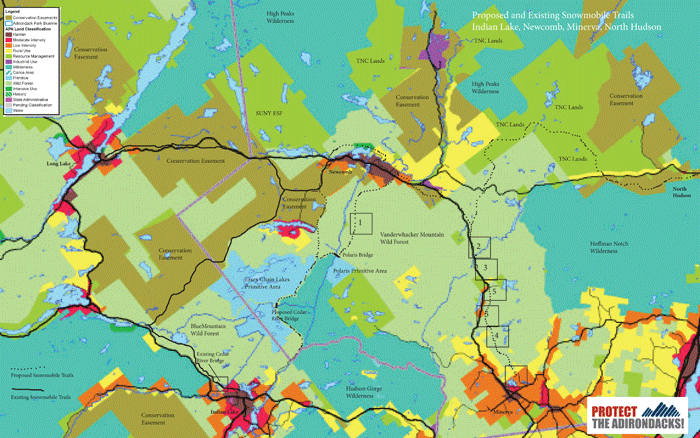
Map of part of the overall new snowmobile trail system that the Department of Environmental Conservation and the Cuomo Administration are looking to build.
Click here for a large format map in PDF.
One factor frequently omitted in APA-DEC public planning is that there is already a snowmobile bridge over the Cedar River six miles upriver, located 1.5 miles east of Route 30, in the Blue Mountain Wild Forest Area (see map above). This is a major bridge over a major river. The existence of this bridge is never mentioned in the public planning and review regarding the possibility of building a second bridge over the Cedar River to access the Chain Lakes Road.
The “Snowmobile Trail Guidance” recognizes the major financial investment to build and maintain snowmobile trails in the Forest Preserve as well as the negative ecological impacts of these major trail systems on natural resources. In light of these considerations, the “Guidance” states clearly that trail redundancy is prohibited. What is more redundant than two snowmobile bridges six miles apart over the same river?
The DEC has so far refused to consider upgrading the existing snowmobile trail from Indian Lake to Newcomb. This trail connects to downtown Newcomb where it could easily connect with new trails from Newcomb to North Hudson and Minerva. The new routes through the Vanderwhacker Mountain Wild Forest area are simply not needed.
The two options for new class II community connector snowmobile trails proposed to be cut through the Vanderwhacker Mountain Wild Forest area will violate the NYS Constitution because of the great number of trees to be cut and the vast alteration of the natural terrain which undermines constitutional protections that these lands be “forever kept as wild forest lands.”
Complaints have been made that the section of this trail within the Blue Mountain Wild Forest area is only a class I snowmobile trail, hence it does not allow for higher rates of speed or grooming with larger motor vehicles. Before the APA-DEC move the build a new Class II Community Connector snowmobile trail, along with a second bridge over the Cedar River, an investigation should be made into upgrading the existing trail from class I to class II.
PROTECT is puzzled by the need for a second major snowmobile trail to connect Newcomb and Indian Lake as well as by the failure of the APA-DEC to consider improvements to the existing trail in this age of tight Forest Preserve stewardship resources.
Last, the 2006 NYS Snowmobile plan clearly states that preference for snowmobile trails should be on private lands and conservation easement lands and that the Forest Preserve should be the last consideration. It appears that APA-DEC planning has started with the Forest Preserve and not with other options.
Draft UMP Proposes Mountainbike Use on former Logging Roads
The draft UMP proposes mountain bike use on a series of former logging roads. PROTECT is dubious that there is a public interest for mountain bike riding on these dirt roads because there is so little mountainbike riding on the dirt roads of other WIld Forest areas in the Forest Preserve. There is not much riding in places like the Moose River Plains Wild Forest, other than race week of the Black Fly Challenge, or places like the Jessup River Wild Forest, Black River Wild Forest, or Ferris Lake Wild Forest. The major issue is that mountain biking is not allowed in a Primitive Area and the APA must revise the SLMP in order to support it.
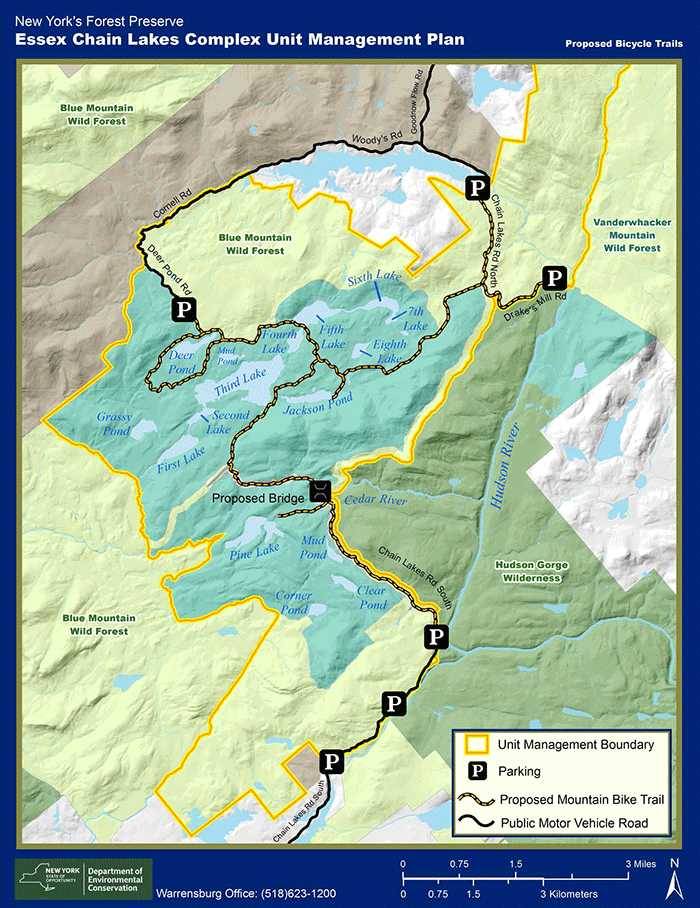
This map shows a proposal for mountain biking along some of the former logging roads in the Essex Chain Complex Area.
Essex Chain Lakes Plan Violates “Forever Wild” Clause of the State Constitution
The new road-like, class II community connector snowmobile trails are not built to facilitate hiking, mountainbiking, horseback riding, or cross-country skiing. No other recreational use in the Forest Preserve requires 9-11 foot wide trails. Class II community connector snowmobile trails are specifically designed and constructed to allow regular grooming with large multi-ton motor vehicles and high speed snowmobile travel. Unlike other trails built by hand, these trails are excavated with heavy machinery, utilize extensive bench cutting, remove thousands of trees over 3 inches diameter at breast height (DBH), remove tens of thousands of trees under 3 inches DBH, remove the entire native understory, often replace the native understory with a grass mix, open the forest canopy, often fracture and chip away bedrock, utilize oversized bridges often equipped with reflectors, and are built to handle operation of motor vehicles at high rates of speed. No other recreational activity in the Forest Preserve, outside of Intensive Use Areas, requires such profound terrain alteration and destruction of natural resources. Protect the Adirondacks believes that this network of “trails” violates the SLMP and Article XIV, Section 1 of the NYS Constitution.
See pictures below of class II community connector snowmobile trails.
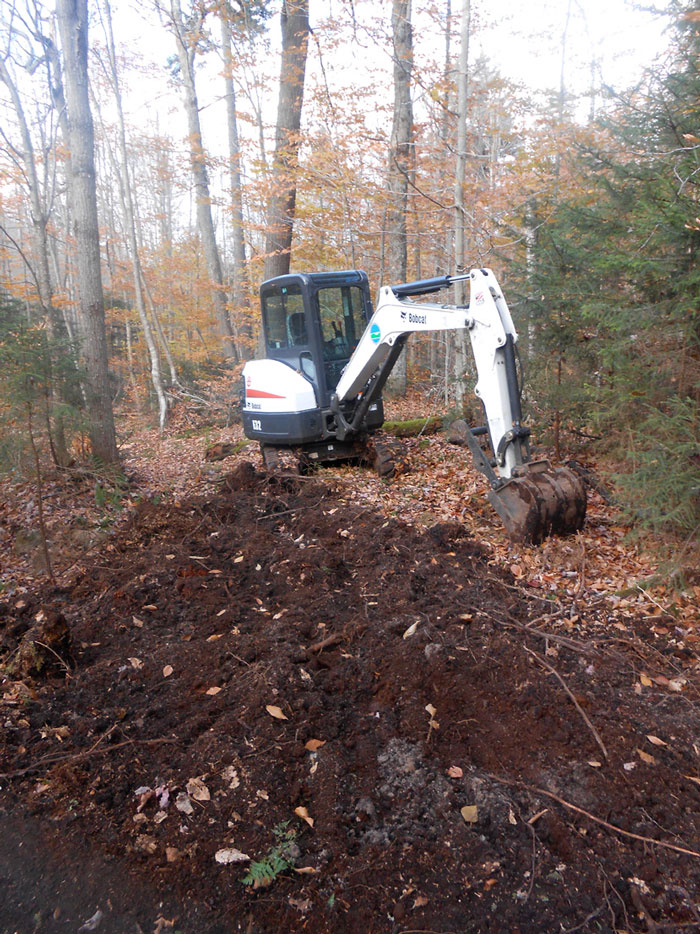
Class II community connector snowmobile trails are designed and constructed in ways far different than any other type of trail on the Forest Preserve.
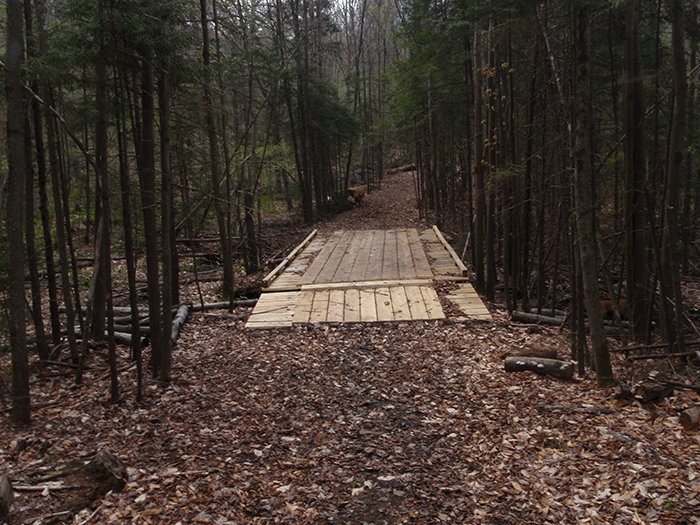
The Seventh Lake Mountain Trail, a class II community connector snowmobile trail in the Moose River Plains Wild Forest area, includes dozens of large 12-foot-wide bridges to support multi-ton groomers. This is a design feature that is not used for foot trails.
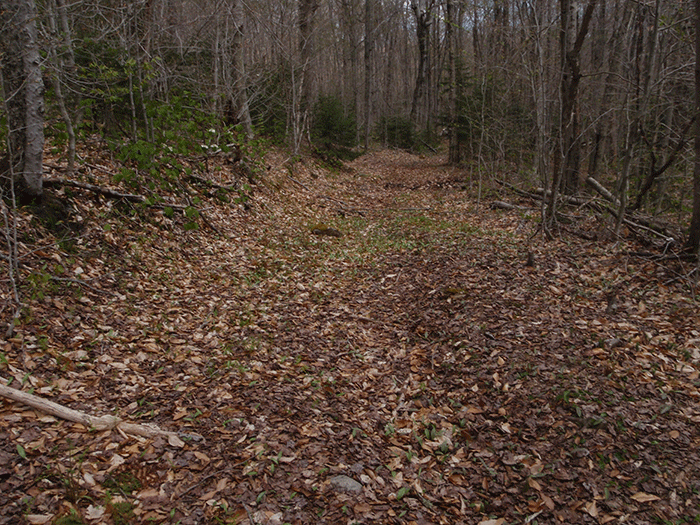
The Seventh Lake Mountain Trail, a class II community connector snowmobile trail in the Moose River Plains Wild Forest area, includes thousands of feet of “bench cuts” into hillsides like those pictured above. These trails are heavily graded and excavated. This is a design feature that is not used for foot trails.
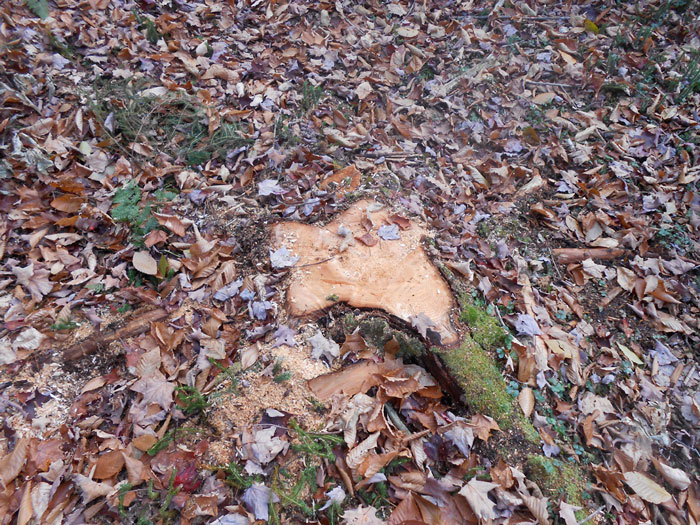
Class II community connector snowmobile trails often require the destruction and removal of thousands of trees over 3 inches or greater in diameter and tens of thousands of trees less than 3 inches. No other type of Forest Preserve trail requires this immense level of tree cutting and destruction of the forest.
Send in you letter today. Public comments must be received by the DEC by July 27th.
Corrie O’Dea, Forester
New York State Department of Environmental Conservation
232 Golf Course Road
Warrensburg, NY 12885
Via email: r5.ump@dec.ny.gov


